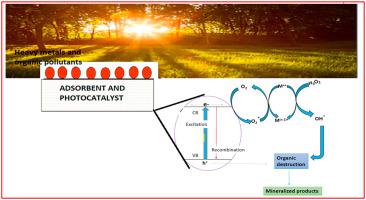Chemosphere ( IF 8.1 ) Pub Date : 2020-09-17 , DOI: 10.1016/j.chemosphere.2020.128379 Timothy O. Ajiboye , Opeyemi A. Oyewo , Damian C. Onwudiwe

|
The co-existence of heavy metals and organics in industrial effluents is a prevalent problem. These pollutants usually have dissimilar compositions and properties, making their complete removal very tedious even with the use of conventional methods. In some cases, organics and heavy metals usually exist in a mixed matrix in industrial wastes. This poses harmful health risks to humans, aquatic lives and the entire ecosystem, because majority of these mixed pollutants amass in water in concentrations which are more than the permissible discharge limits in the environment. Therefore, it is highly necessary to remove these pollutants in order to prevent them from contaminating both the surface and ground water. Although, the remediation of organic compounds and heavy metals (such as Hg, Pb, Cd, As and Cr) could be easily achieved individually. However, these pollutants exist together in many industrial effluents and even in surface waters, hence the complete removal of these pollutants concurrently in a polluted system is the focus of this study. Several technologies have been used for the simultaneous removal of organics and heavy metal pollutants from water, which includes adsorption, ion exchange, photocatalysis, and coagulation. The success of these techniques depends on the water matrices and the choice of water treatment media such as adsorbents, resins, photocatalysts, and coagulants. The advantages and limitations of these technologies together with their respective mathematical modelling is critically examined in this review. Finally, the effect of joint existence of organic pollutants and heavy metals on the removal efficiency were examined in addition to the mathematical models that discusses the mechanisms of their combine elimination.
中文翻译:

从工业废水中同时去除有机物和重金属的研究进展
工业废水中重金属和有机物的共存是一个普遍的问题。这些污染物通常具有不同的组成和性质,即使使用常规方法,也将其完全去除非常乏味。在某些情况下,有机废物和重金属通常以混合基质形式存在于工业废物中。这对人类,水生生物和整个生态系统构成有害的健康风险,因为这些混合污染物中的大多数会在水中积聚,其浓度超过环境中允许的排放限值。因此,非常有必要去除这些污染物,以防止它们污染地表水和地下水。尽管可以轻松实现有机化合物和重金属(例如Hg,Pb,Cd,As和Cr)的修复。然而,这些污染物一起存在于许多工业废水中,甚至存在于地表水中,因此,在污染系统中同时完全清除这些污染物是本研究的重点。几种技术已用于同时从水中去除有机物和重金属污染物,包括吸附,离子交换,光催化和凝聚。这些技术的成功取决于水基质和水处理介质(例如吸附剂,树脂,光催化剂和凝结剂)的选择。本文对这些技术的优点和局限性以及它们各自的数学模型进行了严格审查。最后,











































 京公网安备 11010802027423号
京公网安备 11010802027423号